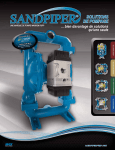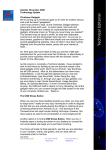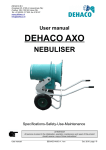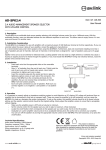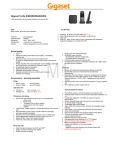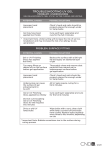Download MAINTENANCE & TROUBLESHOOTING GUIDE
Transcript
MAINTENANCE & TROUBLESHOOTING GUIDE SENTRY INLET STABILIZERS (J MODEL SERIES U.S. PATENT #6,089,837) PREVENTATIVE MAINTENANCE SENTRY Inlet Stabilizers require very little maintenance. The rubber bladder is the only wear part of the unit. Bladder replacement should be part of the system preventive maintenance program. Bladder life is a function of many variables. Normal life can be from a few months to several years depending upon usage, system design, and/or the harshness of the process fluid and application temperature. SENTRY units used in conjunction with diaphragm pumps should have the rubber bladder replaced at least every second time the diaphragms in the pumps are replaced. As with any pumping system, component wear is dependent upon many factors; therefore, this suggested maintenance program might need to be adjusted based upon specific applications. Periodic inspection of units should be as follows: 1. The housings and fasteners should be inspected for signs of over pressurization, stress, fatigue, corrosion, or UV attack. Housings and fasteners must be replaced at the first indication of deterioration. 2. Fastener tightness should be checked before initial start-up. Consult factory for torque specifications. 3. Fasteners on metal units should be replaced at each re-assembly. 4. Check the gas pre-charge in the unit while no system pressure is present. If there is system pressure present, the gauge will display the system pressure, NOT the pre-charge pressure. 5. Check the pressure gauge during operation. If the stabilizer is properly charged, the gauge needle should be fluctuating with each pump discharge stroke. Replace the gauge if needed. EFFECTIVE DAMPENING TIPS The primary factors that determine the level of inlet stabilization obtained with a SENTRY unit are capacity, location, and the charge in the stabilizer. CAPACITY The unit must be properly sized so that the volume of compressed gas inside is enough to absorb fluid shock, and also enough liquid volume capacity to accumulate the fluid pulse. A key element of effective dampening is the relationship of the gas charge to the fluid volume necessary for the pressure range required. An undersized unit will result in insufficient dampening and lead to excessive bladder wear and early failure. The capacity of an inlet stabilizer must be in the correct ratio to the volume per stroke and the number of heads on the pump. The larger the ratio, the higher the level of stabilization. For an Air Operated Diaphragm pump the ratio between the dampener capacity and the pump stroke volume should be from 1.5:1 to 5:1, based upon the level of stabilization required. For a metering pump the ratio is 10:1 to 30:1, based upon the level of stabilization required. LOCATION Location is important because of wave frequency and fluid dynamics. The location of the stabilizer has a direct bearing on its performance. The stabilizer must be no further than 10 pipe diameters from the pump inlet and installed on a tee in the fluid flow path. Do not install the stabilizer on a branch or riser. The farther away the inlet stabilizer’s fluid port is from the pump inlet, the less effective the unit will be. CHARGE The gas charge in the stabilizer will vary by application. The charge in the unit is critical to the units’ performance. To properly charge the unit, an accurate reading of the system fluid pressure is required. A compound pressure/vacuum gauge should be installed on the system piping upstream from the unit. Any time the gas charge in the stabilizer is equal to or greater than the system pressure, the unit will not function. Over charging will force the internal bladder down, covering the inlet port. This in effect shuts off the unit. See the Troubleshooting section on the next page. The patented “J” Model Inlet Stabilizer includes a venturi valve, an airtight ball valve and a compound pressure/vacuum gauge. It does not require a permanent air/gas supply. For suction lift, a vacuum must be created in the air chamber of the unit. For positive inlet pressure, the unit must be pre-charged prior to the introduction of the system’s fluid pressure. Refer to the installation instructions for more detail. TROUBLESHOOTING NO STABILIZING OR INSUFFICIENT STABILIZING EFFECT First observe the needle on the inlet stabilizer’s pressure gauge. The needle should be cycling in sequence with the minimum and maximum pressure fluctuations created by the pump’s stroking action. If the needle is steady, the stabilizer is either over pressurized, contains no pressure, or the fluid inlet port is restricted. 1. Check the air charge setting of the unit. Inlet Stabilizers in positive suction applications need the air charge to be set at 50% of the static inlet pressure. In suction lift applications the Stabilizer needs to be set at approximately 5-6 inches of vacuum. Refer to the Installation Instructions for charging information. 2. Check the location of stabilizer. It should be mounted on a tee in the fluid flow path within 10 pipe diameters or closer to pump inlet. The use of elbows and risers will decrease performance. 3. Check the capacity of the stabilizer in relation to the pump stroke volume. An undersized stabilizer will decrease performance and shorten bladder life. 4. Check for bladder failure. Replace the bladder. 5. Check the inlet fluid port of the unit for blockage or restriction. Clear the obstruction or remove the restriction and reinstall the unit according to the installation instructions. LEAKING FLUID OR AIR 1. All plastic and PTFE components take an initial set after manufacture. The fasteners may need tightening. Consult factory for torque specifications. 2. Check the air controls and gauge threads for an airtight seal. specifications. Tighten if needed. Consult factory for torque 3. Check the ring flange or clamp band bolts for proper torque. specifications. Tighten if needed. Consult factory for torque 4. Check for a bladder rupture. Replace the bladder if it has failed. BLADDER RUPTURE OR FAILURE CAUTION: IF A SYSTEM PRESSURE TEST IS TO BE PERFORMED, THE UNIT MUST BE CHARGED WITH 80% OF THE SYSTEM TEST PRESSURE PRIOR TO THE TEST. THIS WILL AVOID POSSIBLE BLADDER DAMAGE. MAXIMUM PRESSURE IS 30 PSI. 1. Chemical Attack Swelling, hardening, and distortion are some of the indications of chemical attack. Check the chemical compatibility charts. Consult factory for assistance. 2. Cut Bladder Check for a sharp object that may have been introduced into the stabilizer through the pumped fluid. 3. Torn Bladder A. Check for an insufficient air charge in the unit during operation. Properly charge the unit for the application. B. A transient high-pressure spike created by pump start up, pump shut down, a vertical pipe run, or quick closing valve can destroy a bladder. A Surge Suppressor should be installed at the location where a pressure spike originates. 4. Excessive Bladder Wear A. Check the size of the unit. An undersized unit does not have the capacity to absorb the volume of the pump stroke, forcing the bladder to be overworked. B. Check the air charge in the unit. An undercharged unit will allow the bladder to excessively rub and wear against the internal body housing. BLACOH FLUID CONTROL, INC. 601 COLUMBIA AVE. BLDG. D, RIVERSIDE, CA 92507 USA TEL: 800.603.7867 or 951.342.3100 Fax: 951.342.3101 e-mail: [email protected] web site: www.blacoh.com L-352 REV: 11/09/04


